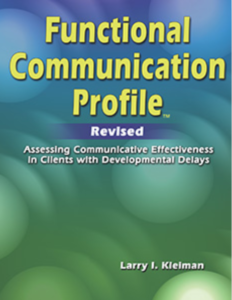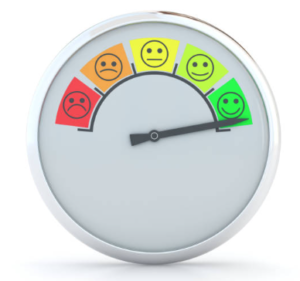Giving the Functional Communication Profile
The Functional Communication Profile – Revised (FCP-R) is a valuable tool for assessing the communication abilities of individuals who may not be easily evaluated using standardized measures. This observational-based assessment can be used with all forms of communication, including verbal and nonverbal, and augmentative methods, and allows for administration across locations and timeframes, as well as input from multiple service providers and caregivers.

It’s primarily used for clients who are not easily assessed using standardized measures, which require children to sit in a chair, attend to tasks, and point to various objects or pictures. Before creating a report template for the Functional Communication Profile – Revised (FCP-R), I didn’t realize how often it was used. I thought it was often a last resort since schools and insurance require a standard score.
Two of the strengths of the FCP-R are that it is observational-based and can be used with all communication modalities (e.g., gestures, vocalizations, pointing). It also allows room for administration across time and location as well as input from multiple educators and caregivers. Standardized measures do not have this flexibility unless you modify the administration which may negate the scores. For example, covering up a portion of the stimuli to decrease the visual field from four to two. ⬇️


Functional Communication Profile – Revised Assessment Areas
Individuals are observed and rated in the following areas:
- Sensory: Evaluates sound localization, visual ability, and eye contact
- Motor: Evaluates gross-motor skills, fine-motor skills, and self-help skills
- Behavior: Evaluates appropriateness of behaviors in response to environmental stimuli
- Attentiveness: Evaluates attention span, alertness, response levels, cooperation, and level of awareness
- Receptive Language: Evaluates comprehension of basic concepts, ability to follow directions, responsiveness to name, and ability to point to items or pictures when named
- Expressive Language: Evaluates verbal and nonverbal communication, vocabulary, grammar, and phrase length, and ability to express thoughts and ideas
- Pragmatic/Social Language: Evaluates ability to show communicative intent, to ask and answer questions, maintain a conversation, participate in turn-taking; initiate topics, and elaborate on details for listener
- Speech: Evaluates intelligibility, sounds produced, dentition, and oral-motor imitation
- Voice: Evaluates loudness, vocal quality, and pitch
- Oral: Evaluates mouth breathing, drooling, tongue thrust, and swallowing/diet
- Fluency: Evaluates speaking fluency, rate of speech, and rhythm and intonation
Scoring the Functional Communication Profile – Revised
The FCP-R does not have a standardized scoring system. Each assessment area is rated on a subjective decision by the evaluator based on responses in the assessment areas and general impressions. The rating scale ratings are typical, mild, moderate, severe, and profound. Depending on the individual test item, the client is rated on various parameters such as severity, frequency of occurrence, mode of communication, degree of independence, quality of performance, and inventory of skills.

Mild Rating
With mild deficits, a communication disorder is present, but the child can communicate effectively most of the time with minimal support. These are the clients who can follow directions but may need repetition or simplification at times. They are able to absorb most academic information provided in class but may need extra time to process or apply new concepts. Their deficits may not even be observed outside of the academic setting. Unfamiliar listeners can understand and communicate with them easily.
Moderate Rating
Clients with moderate deficits have difficulty communicating effectively without any support. Their communication disorder is having a noticeable impact at school (and at home). These clients need cues, repetition, modeling, and/or further explanations to understand the material or follow directions. These students need a considerable amount of extra time to process or apply new concepts. Unfamiliar listeners may ask the client to repeat themselves or clarify information.
Severe Rating
Clients with severe deficits have difficulty participating in a regular education classroom and communicating their basic wants and needs even with support. They may be nonverbal or have limited verbal output, such as single words or syllables. These clients typically do not initiate requests or interactions unless prompted. Familiar and unfamiliar listeners may have difficulty understanding and recognizing communicative attempts.
Profound Rating
Clients with profound deficits need lots of support to have their needs met. If using AAC, these clients may need hand-over-hand support to make requests known. Communication and academic teaching focus on basic needs (i.e., toileting, hunger, thirst, pain). Since communication may be limited to vocalizations (sounds) or behaviors that are usually seen as disruptive (e.g., squealing, hair pulling, biting, stomping), familiar and unfamiliar listeners have difficulty understanding, or even recognizing, communicative attempts.
For more info on report writing, check out these resources- ⬇️
Blog post: Write a Great Speech and Language Report
FREE course: Write Speech and Language Reports Like a Boss
